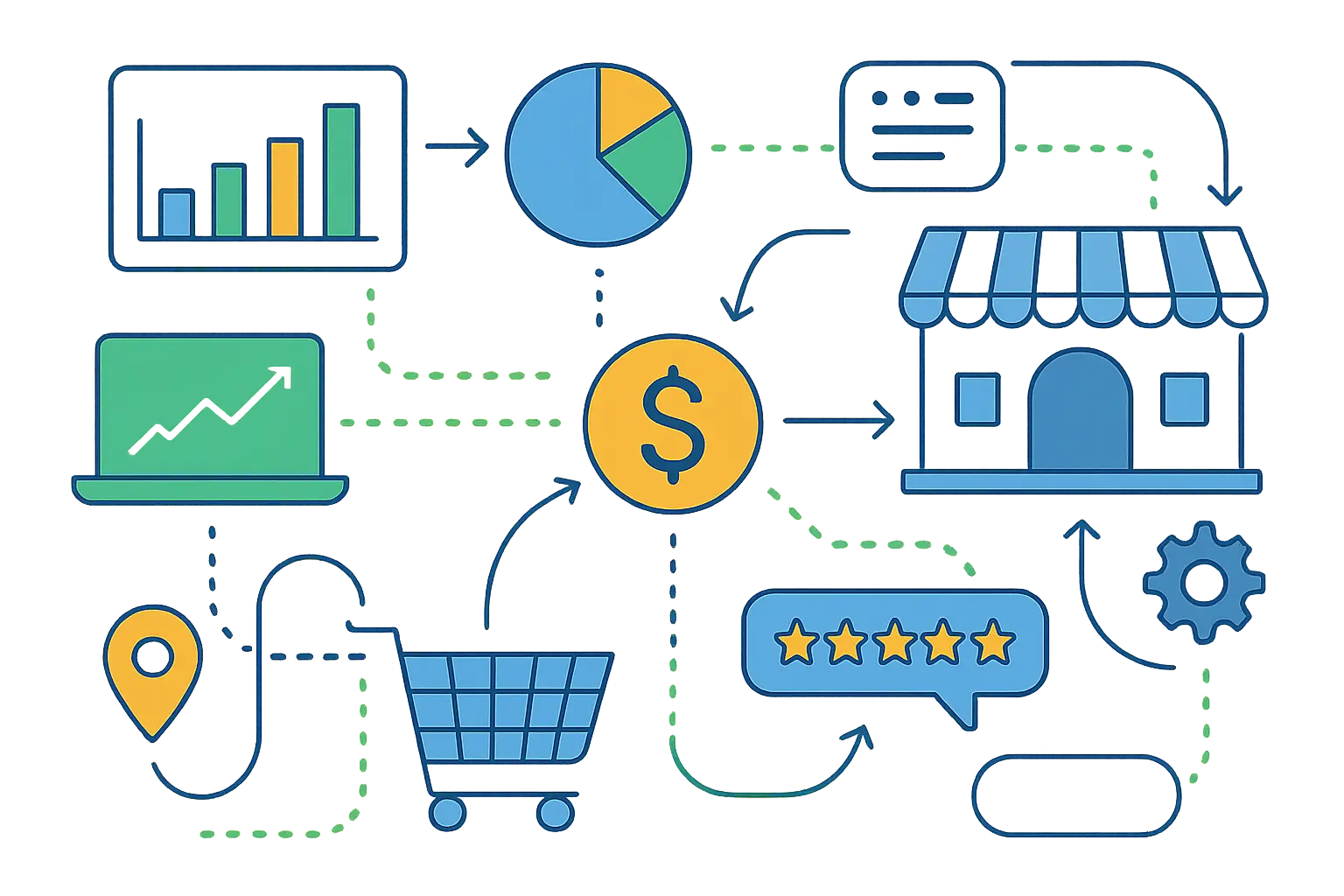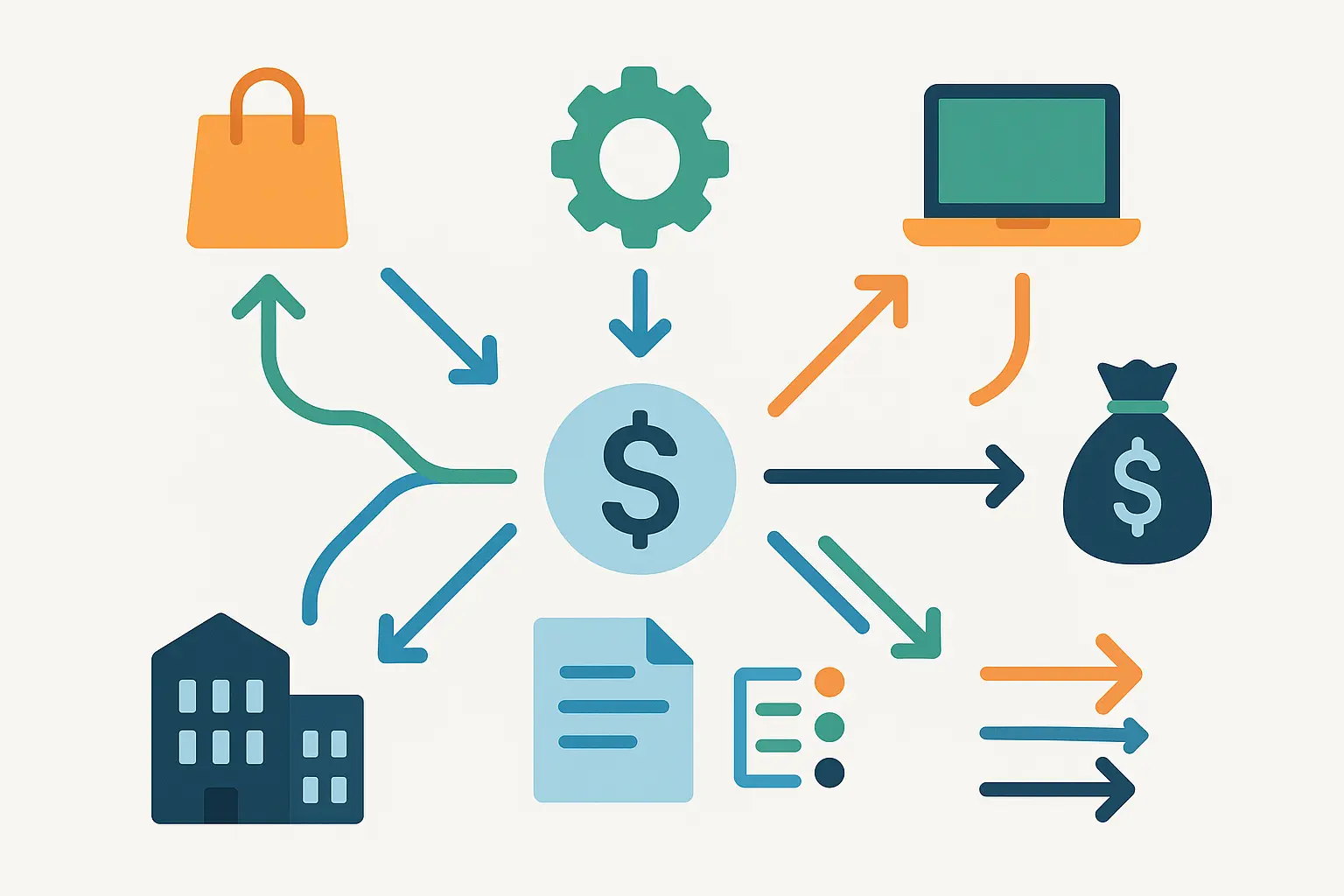Table of Contents
-
How Yelp Evolved From Simple Reviews to Business Empire
-
Why Most Businesses Fail at Yelp (And How Winners Think Differently)
-
Real Success Stories That’ll Make You Rethink Your Strategy
-
The Step-by-Step Blueprint That Actually Works
-
What’s Coming Next in Local Business Discovery
TL;DR
-
Yelp went from being just another review site to this massive ecosystem that can literally make or break your business
-
Their algorithm is way smarter than people think – it rewards genuine engagement over fake review schemes
-
Smart businesses treat Yelp like a sales channel, not just damage control for bad reviews
-
Real businesses are seeing 23-67% revenue bumps when they nail their Yelp strategy
-
Google and social media are eating Yelp’s lunch, but there’s still money to be made if you know what you’re doing
-
The future’s all about mobile-first thinking and AI that knows what customers want before they do
How Yelp Evolved From Simple Reviews to Business Empire
I remember when Yelp was just that site where angry people complained about restaurants. Now? It’s this massive machine that can make or break local businesses overnight. With 178 million unique visitors every month scrolling through mobile, desktop, and app versions, the platform didn’t just add features – it completely reimagined what a review site could be.
The genius behind Yelp’s evolution is what I call a “self-feeding monster.” Users write reviews, which attract more users, which brings in businesses, which creates more content. It’s brilliant, really. But here’s what most people miss: Yelp isn’t just hosting reviews anymore. They’re controlling entire customer journeys from discovery to purchase.

The Foundation That Changed Everything
The platform’s secret sauce isn’t just collecting reviews – it’s how they’ve gamified the whole experience. Elite reviewers get perks, businesses get analytics, and regular users get that dopamine hit from helpful votes. Everyone wins (theoretically).
What blows my mind is how Yelp cracked the authenticity code. Their algorithm doesn’t just count stars; it weighs reviewer credibility, photo quality, check-in frequency, and dozens of other signals. A review from someone who’s been active for years carries way more weight than a brand-new account dropping a five-star bomb.
How Reviews Actually Get Ranked
Here’s something that’ll shock you: not all reviews are created equal in Yelp’s eyes. I’ve watched businesses obsess over getting more reviews, completely missing that a single detailed review with photos from an established user can outweigh ten generic “great service!” comments. This yelp case study phenomenon shows exactly why understanding the platform’s ranking system is crucial for business success.
The platform tracks everything. How long did the reviewer spend writing? Did they upload photos? Have they checked in at the location? Are they connected to other users who’ve reviewed the business? It’s like having a lie detector for every piece of content.
The filtering system (which businesses love to hate) actually serves a purpose. Sure, it sometimes catches legit reviews, but it’s also stopping the fake review factories that would otherwise destroy the platform’s credibility. Approximately 76% of reviews are recommended by Yelp’s system and contribute to each business’s rating, while the automated filtering system hides roughly 24% of sketchy reviews to reduce spam.
|
Review Quality Factors |
Weight in Algorithm |
Business Impact |
|---|---|---|
|
Reviewer Account Age |
High |
Established users carry more influence |
|
Photo Uploads |
High |
Visual content increases credibility |
|
Check-in History |
Medium |
Location verification adds authenticity |
|
Review Length/Detail |
Medium |
Comprehensive reviews rank higher |
|
Helpful Votes Received |
Medium |
Community validation boosts visibility |
|
Network Connections |
Low |
Social proof through user relationships |
Making Your Business Profile Work Harder
Your Yelp profile isn’t a “set it and forget it” situation. I’ve watched businesses upload a logo and wonder why they’re not getting results. Meanwhile, their competitors are treating their profiles like mini-websites.
Professional photos matter way more than you think. We’re talking about your storefront, your team, your process, your results. People want to see what they’re getting into before they walk through your door. A business with 1-5 reviews and at least 10 photos sees as much as 200% more user views than a business with the same number of reviews but no photos.
The businesses crushing it on Yelp update their profiles constantly. New services? Update it. Seasonal promotions? Post about it. Team changes? Show the faces. Yelp rewards fresh content, and customers definitely notice the difference.
Profile Optimization Checklist:
-
Complete all profile fields (hours, contact, services)
-
Upload 15+ high-quality photos (storefront, products, team, process)
-
Write detailed service descriptions with natural keywords
-
Add seasonal updates and promotions monthly
-
Include behind-the-scenes content
-
Respond to all reviews within 24 hours
-
Update business hours for holidays/special events
-
Add new services and offerings immediately
Understanding How People Actually Use Yelp
Most people don’t just randomly stumble onto your Yelp page. They’re on a mission. Maybe they need a plumber at 10 PM, or they’re planning a date night, or they’re new to town and need a dentist.
The search behavior is fascinating. People start broad (“restaurants near me”), then get specific (“Italian restaurants with outdoor seating”). They filter by rating, distance, price. Then comes the deep dive – reading reviews, looking at photos, checking hours.
What kills me is watching businesses optimize for the wrong part of this journey. They obsess over their star rating but ignore the fact that people are reading their responses to negative reviews. That’s where trust gets built or destroyed.

How Yelp Actually Makes Money (And Why You Should Care)
Yelp’s running a business here, and they’ve built multiple ways to extract money from the ecosystem they created. Understanding their business model helps you navigate their platform way more effectively.
The advertising side is obvious – businesses pay for better placement, highlighted listings, and targeted ads. But the transaction services are where things get interesting. Yelp takes a cut when you book through their platform, order delivery, or make reservations.
The Advertising Game That Most Businesses Play Wrong
Yelp Ads aren’t Google Ads. The mindset is different, the targeting works differently, and the results show up differently. I’ve seen businesses blow their budgets because they approached Yelp advertising with a Google mentality.
The targeting options are actually pretty sophisticated. You can target by location radius (obviously), but also by customer demographics and even competitor positioning. Want to show up when people are looking at your biggest rival? Yelp will let you do that.
Here’s the thing though – throwing money at Yelp Ads won’t fix a fundamentally broken profile. If your organic presence sucks, your ads will just drive traffic to a disappointing experience. Fix the foundation first.
With 515,000 paying advertising locations as of mid-2025 and advertisers spending about 8% more per business page in 2024, the competition for visibility is getting intense.
Transaction Services That Change the Game
The reservation and booking features are genius from Yelp’s perspective. They’re inserting themselves directly into the transaction, taking a commission while making themselves indispensable to both sides.
For restaurants, Yelp Reservations competes with OpenTable. For service businesses, they’re going after the appointment booking market. The convenience factor is real – customers can discover, research, and book without leaving the platform.
But here’s what businesses need to consider: every transaction through Yelp is a transaction where they control the customer relationship. You’re trading convenience for customer data and direct relationships.

The Algorithm That Decides Your Fate
Look, Yelp’s algorithm is basically a black box that everyone’s trying to crack. But after watching hundreds of businesses succeed and fail on this platform, some patterns become pretty obvious.
Sure, being close to your customers matters, but it’s not everything. I’ve seen businesses with killer reviews and solid engagement completely outrank their closer competitors who have mediocre profiles. The algorithm seems to love businesses that actually contribute to making the platform better.
Here’s something that’ll blow your mind – how fast you respond to reviews is huge. Businesses that jump on both positive and negative reviews quickly and professionally get serious algorithmic love. Makes sense when you think about it – Yelp wants to promote businesses that actually engage with their community, not ones that just collect reviews and disappear.
How Yelp Impacts Your Google Rankings
Okay, this is where it gets interesting. Most business owners have no clue that crushing it on Yelp actually helps their Google rankings. Google treats Yelp like a trusted friend – if Yelp says you’re legit, Google listens.
This interconnected relationship between platforms highlights why businesses need comprehensive SEO strategies that consider all ranking factors rather than focusing on individual platforms in isolation.
The NAP thing (Name, Address, Phone) is crucial but boring. Google’s constantly cross-checking your business info across the web, and Yelp is one of the major sources they use. Get it wrong, and you’re confusing the algorithm.
But here’s where it gets deeper – Google’s looking at your review patterns, how fast you’re getting new reviews, and how engaged your customers are across multiple platforms. A business that’s killing it on Yelp often sees their Google My Business performance improve too. It’s all connected.
Why Most Businesses Fail at Yelp (And How Winners Think Differently)
The Yelp game has changed completely. What worked five years ago might actually hurt you today. The platform’s fighting on multiple fronts, and honestly, most businesses are still using outdated playbooks.
Google basically came in and said “hold my beer” to Yelp’s entire business model. When they started showing business reviews, ratings, and photos right in search results, they made Yelp feel… unnecessary for a lot of people. Why click through to another site when everything you need is right there?
Then social media crashed the party. Instagram and TikTok aren’t just for millennials posting lunch photos anymore – they’re legitimate business discovery platforms. Younger customers might never even think to check Yelp.
According to Nielsen research, 85 percent of consumers find local business information online, highlighting the massive shift toward digital discovery that Yelp helped pioneer but now must compete in.
The Google Problem That’s Eating Yelp’s Lunch
This one’s painful to watch. Google didn’t just compete with Yelp – they made them irrelevant for tons of searches. Someone searches “pizza near me” and boom – Google shows a map, ratings, reviews, photos, even ordering options. No Yelp needed.
That local pack (those three businesses in Google’s map results) gets most of the clicks. If you’re not there, you’re fighting for scraps. And guess what influences those rankings? Your Google My Business profile, not your Yelp one.
Don’t get me wrong – Yelp isn’t dead. But the strategy has to be completely different now. It works best as part of a bigger local SEO plan, not as your main thing.

Social Media Platforms Stealing Yelp’s Thunder
Instagram’s location features are scary good for visual businesses. Restaurants, salons, retail stores – anywhere that photographs well can build massive followings through location tags and hashtags.
TikTok’s algorithm is honestly terrifying at showing people local businesses they didn’t even know they wanted. One viral video about your business can drive more traffic than years of Yelp grinding.
Facebook’s local features are underrated. Reviews, events, messaging, marketplace listings – it’s like having a mini-website with built-in social proof.
The big difference? Social media feels more personal and trustworthy to most people. A recommendation from someone in their network hits different than a review from a stranger on Yelp.
Trust Issues That Won’t Go Away
Yelp’s reputation has taken some serious hits over the years. The whole “pay-to-play” thing (whether it’s true or not) created this cloud of suspicion that affects how everyone views the platform.
The review filtering system is necessary but creates ongoing drama with businesses. When legit reviews get filtered, business owners feel like they’re getting screwed. When fake reviews slip through, customers lose trust in the whole platform.
Those extortion claims (businesses saying Yelp manipulates reviews based on ad spend) just won’t die, even though Yelp consistently denies them. In this game, perception matters as much as reality.
Beginning in 2013, a handful of tech companies (including Yelp) began to research and release data on the diversity of their workforces, showing how platform transparency issues extend beyond reviews to corporate practices that affect user and business trust.
The Fake Review Problem That Hurts Everyone
Fake reviews are everywhere, and they’re getting sophisticated. Gone are the days of obviously fake “Great service! Five stars!” garbage. Now you’ve got fake reviewers with established profiles, detailed reviews, even photos.
Yelp’s filter tries to catch these, but it’s an arms race. As fake review operations get smarter, the filtering gets more aggressive. Unfortunately, that means legitimate reviews sometimes get caught in the crossfire.
I’ve watched businesses lose dozens of real reviews to the filter while their competitors seem to have obviously fake reviews that slip through. It’s frustrating as hell and creates an uneven playing field.
Balancing Business Interests vs. Editorial Integrity
Yelp’s walking a tightrope between keeping businesses happy (so they’ll advertise) and keeping users happy (so they’ll keep using the platform). It’s not easy.
Businesses that advertise don’t get better reviews or higher rankings (according to Yelp), but they do get better placement and more visibility. The question is whether that creates an unfair advantage that undermines the platform’s credibility.
Users are getting savvier about these dynamics. They’re starting to question whether the businesses they see first are actually the best, or just the ones paying for placement.
Real Success Stories That’ll Make You Rethink Your Strategy
Theory’s nice, but results are what matter. I’ve tracked dozens of businesses that transformed their Yelp presence from total liability to serious asset, and the patterns are pretty clear.
The businesses that succeed don’t treat Yelp like a side project. They approach it with the same strategic thinking they’d use for any other marketing channel. They measure stuff, adjust when it’s not working, and double down on what is.
What’s crazy is that the most successful Yelp strategies often go against what everyone thinks they should do. It’s not about getting the most reviews or the highest rating – it’s about creating genuine connections with customers and providing value beyond just doing the job.

Restaurant Success Stories That Changed Everything
Restaurants have the most mature playbook for Yelp success, and when it’s done right, the results can be insane. I’ve watched struggling restaurants completely turn around their business through smart Yelp optimization.
The Pizza Chain That Cracked the Code
This pizza chain was doing okay, but they weren’t dominating their local markets like they wanted. Their Yelp profiles were basic – a few photos, inconsistent info, and they’d respond to reviews whenever they remembered to.
The transformation started with getting their act together across all locations. Every single review got a response within 24 hours. We’re talking personalized responses that showed they actually read what customers wrote, not generic copy-paste garbage.
They invested in professional food photography for each location, showing the prep process alongside the final products. Customers eat that behind-the-scenes stuff up, and it builds trust in your food quality.
The promotional campaigns were targeted by location, highlighting local community involvement and seasonal specials. They weren’t just selling pizza – they were positioning themselves as neighborhood gathering places.
Results? Average store revenue jumped 23% over 12 months, with the best locations seeing even bigger gains. More importantly, customer retention improved because the Yelp optimization forced them to focus on consistent service quality.
In the case of restaurant businesses, a one-star increase in reviews can result in a 5% to 9% increase in revenue, demonstrating the direct correlation between review quality and business performance.
The Bistro That Rose From the Dead
This bistro was in serious trouble. 2.8-star rating on Yelp, declining foot traffic, reputation for inconsistent service. The owner was literally considering closing when they decided to make one last push.
The recovery strategy was aggressive but genuine. Every single review – positive or negative – got a personal response from the owner within hours. These weren’t defensive responses, but real acknowledgments and invitations to give them another shot.
They started hosting monthly Yelp Elite events, treating their most influential reviewers like VIPs. Free tastings, behind-the-scenes kitchen tours, meet-and-greets with the chef. These events generated dozens of high-quality reviews with professional-level photos.
The photo strategy was brilliant. They encouraged every satisfied customer to take photos by creating Instagram-worthy presentation and providing perfect lighting at every table. They even offered small discounts for customers who uploaded photos to Yelp.
Eight months later, they’d climbed to 4.3 stars with a steady stream of new positive reviews. More importantly, the changes they made to earn those reviews actually improved the restaurant experience for everyone.
Restaurant Recovery Action Plan:
-
Week 1-2: Respond to all existing negative reviews with personalized apologies and improvement commitments
-
Week 3-4: Actually fix the service quality issues (staff training, kitchen processes, customer service)
-
Month 2: Launch photo-friendly presentation upgrades and lighting improvements
-
Month 3: Host first Yelp Elite event with local food influencers
-
Month 4-8: Keep up consistent review responses, monthly events, and photo encouragement
-
Ongoing: Monitor rating trends and adjust based on what customers are actually saying
Service Business Transformations That Prove the Model
Service businesses have a tougher Yelp challenge than restaurants. You can’t just post pretty food photos and call it a day. Trust is everything, and the sales cycles are way longer.
The businesses that crack this code focus on education and transparency. They use their Yelp profiles to explain their processes, show off their expertise, and address common customer concerns before they become objections.
The HVAC Company That Built a $2M Pipeline
This HVAC company was getting decent work through referrals, but they wanted to scale beyond their existing network. Their Yelp profile was an afterthought – basic contact info and a handful of generic reviews.
The transformation started with content. They began documenting every job with before/after photos, showing the problem, the solution, and the final result. Customers love seeing the transformation, and it proves expertise better than any sales pitch.
Their service descriptions became educational resources. Instead of just listing “AC repair,” they explained common problems, what to expect during service calls, and how to prevent future issues. This positioned them as experts, not just another vendor.
The follow-up system was key. Every completed job triggered a sequence: thank you text within an hour, follow-up call within 48 hours, review request email after a week. Timing mattered – they asked for reviews when the positive experience was still fresh.
Two years later, they’d generated $2.1 million in additional revenue directly from Yelp leads. Their average job size increased because customers came in pre-sold on their expertise, and their closing rate improved because Yelp provided social proof.

The Dental Practice That Doubled New Patients
Dental practices face unique Yelp challenges. People are anxious about dental work, price-sensitive, and looking for reasons to trust you with their health.
This practice studied their competitors’ negative reviews to understand common patient concerns: pain, cost, wait times, communication issues. Then they proactively addressed each concern in their Yelp profile.
Staff introductions were huge. Instead of generic headshots, they created mini-biographies for each team member, highlighting experience, specialties, even personal interests. Patients want to know who’s going to be working on them.
Service descriptions went beyond basic procedures to explain what patients could expect: how long appointments take, what the experience feels like, what happens afterward. They demystified dental work and reduced anxiety.
Patient education content addressed common questions and concerns. They posted about oral health tips, explained different treatment options, shared success stories (with permission). This positioned them as educators, not just service providers.
Results were impressive: 67% increase in new patient bookings over 18 months, with patients specifically mentioning they chose the practice based on their Yelp presence. Treatment acceptance rates also improved because patients came in better educated and more trusting.
94% of customers have claimed that positive reviews on Yelp have made them devoted to the business, giving them first preference whenever they have to make a purchase, highlighting the loyalty-building power of strong Yelp presence.
Retail Success Stories That Bridge Online and Offline
Physical retail locations can use Yelp to create experiences that connect online discovery with in-store visits through community building, event hosting, and user-generated content strategies. Independent retailers can actually compete with big chains by leveraging Yelp’s community features and local focus.
Retail businesses have an interesting Yelp opportunity because they can create experiences that naturally generate user content. The most successful retail Yelp strategies focus on community building and creating shareable moments.
The Bookstore That Became a Community Hub
This independent bookstore was getting crushed by Amazon and big box retailers. They couldn’t compete on price or selection, so they decided to compete on experience and community.
Yelp’s event features became their secret weapon. Weekly author readings, book clubs, literary discussions – everything promoted through their Yelp profile. These events generated reviews, photos, and word-of-mouth marketing.
The community aspect was crucial. Regular customers became advocates, posting photos of purchases, reviewing new releases, recommending the store to friends. The bookstore became a destination, not just a retail location.
They also used Yelp to showcase expertise. Staff recommendations, curated reading lists, literary event coverage positioned them as book experts rather than just book sellers.
Monthly revenue increased 45% over two years, with event attendance driving both immediate sales and long-term customer relationships. More importantly, they built a sustainable competitive advantage that online retailers couldn’t replicate.

The Step-by-Step Blueprint That Actually Works
Enough theory and case studies – you want to know exactly what to do. I’ve distilled the most effective Yelp strategies into a framework that works across industries.
The key is being systematic about it. Most businesses try random tactics and wonder why nothing happens. The businesses that succeed treat Yelp optimization like any other marketing campaign: clear objectives, consistent execution, regular measurement.
This isn’t about gaming the system or buying fake reviews. It’s about genuinely improving your customer experience and making sure that improvement is visible to potential customers.
Profile Optimization That Actually Moves the Needle
Your Yelp profile is your storefront on the platform. Most businesses treat it like a business card when it should function like a sales page.
Complete every single field in your profile. Yelp’s algorithm loves complete profiles, and customers notice the difference between a bare-bones listing and a comprehensive business presence.
Hours, contact info, location data must be 100% accurate and consistent across all platforms. Any discrepancy confuses both algorithms and customers.
|
Profile Element |
Priority Level |
Visibility Impact |
Customer Decision Factor |
|---|---|---|---|
|
Business Hours |
Critical |
High |
High |
|
Photos (15+) |
Critical |
Very High |
Very High |
|
Service Descriptions |
High |
Medium |
High |
|
Contact Information |
Critical |
High |
Medium |
|
Attributes/Categories |
High |
High |
Medium |
|
Regular Updates |
Medium |
Medium |
Low |
Content Strategy That Builds Trust and Drives Action
Content frequency matters more than most businesses realize. Yelp rewards active profiles with better visibility, and customers associate regular updates with reliable businesses.
Photo strategy goes way beyond just having pictures. You need photos that tell your story: your team, your process, your results, your space. Every photo should answer a potential customer question or address a common concern.
Seasonal content keeps your profile relevant. Holiday hours, special promotions, weather-related updates – these small touches show you’re actively managing your presence.
Behind-the-scenes content builds trust like crazy. Show your prep process, introduce your team, highlight your quality standards. Transparency creates confidence.
Over 80% of consumers check Yelp reviews before visiting a store or booking a service, making your profile content crucial for converting browsers into customers.

Keyword Integration Without Looking Spammy
Keyword stuffing will hurt you on Yelp just like it does on Google. The platform’s algorithm is smart enough to recognize and penalize obvious manipulation.
Natural keyword integration works best. Instead of “best pizza restaurant in downtown Chicago,” try “family-owned pizzeria serving downtown Chicago since 1995.” Same keywords, way better user experience.
Service-specific keywords should focus on what customers actually search for, not industry jargon. People search for “emergency plumber,” not “residential plumbing solutions provider.”
Location keywords should be specific and natural. Neighborhood names, local landmarks, nearby businesses help with local discovery without sounding forced.
Review Generation and Management That Builds Relationships
Review generation isn’t about begging for five-star ratings. It’s about creating experiences worth talking about and making it easy for satisfied customers to share their experiences.
Timing is everything with review requests. Ask too early, and customers haven’t had time to appreciate your service. Ask too late, and they’ve forgotten about you.
The most effective review generation happens naturally through exceptional service, but you can create systems that encourage sharing without being pushy.
Finding the Perfect Moments to Ask
The best review requests don’t feel like requests at all. They feel like natural extensions of great customer service.
For service businesses, the sweet spot is usually 3-7 days after completion. Long enough for customers to appreciate the results, recent enough that the experience is still fresh.
Restaurants should focus on the end-of-meal experience. A simple “We’d love to hear about your experience” with a business card containing your Yelp info works way better than aggressive table-side begging.
Retail businesses can tie review requests to purchase follow-ups. “How are you enjoying your new ? We’d love to hear about your experience.”
The key is making it about their experience, not your desperate need for reviews.
Review Request Timing That Actually Works:
-
Service Businesses: Day 5 post-completion via email with project photos
-
Restaurants: End of meal with business card mentioning Yelp
-
Retail: 1 week post-purchase with product care tips and review invitation
-
Healthcare: 2 weeks post-appointment with health tips and experience request
-
Auto Services: 3 days post-service with maintenance reminders and review link
Crisis Management That Turns Negatives Into Positives
Negative reviews aren’t disasters – they’re opportunities to show your customer service publicly. How you handle criticism says more about your business than a dozen five-star reviews.
Response speed matters big time. Acknowledge negative reviews within 24 hours, even if you can’t fix the issue immediately. Quick responses show you’re paying attention and actually care about customer concerns.
Public responses should be professional, empathetic, and solution-focused. Acknowledge the customer’s experience, take responsibility where appropriate, and offer to make things right.
Move detailed discussions offline. “We’d love to make this right. Please call us at [number] so we can discuss this further.” This shows other readers you’re committed to resolution while protecting customer privacy.
Follow up publicly when issues get resolved. “Thanks for giving us another chance to serve you. We’re glad we could resolve this issue.” This shows potential customers that you actually fix problems instead of just apologizing.

Performance Measurement That Proves ROI
You can’t manage what you don’t measure. Yelp success requires tracking the right metrics and understanding how they connect to actual business outcomes.
Platform metrics (views, clicks, calls) are interesting, but business metrics (leads, conversions, revenue) are what actually matter. Connect your Yelp activity to real business results.
Customer lifetime value from Yelp-sourced customers often exceeds other channels because these customers come in pre-qualified and pre-sold on your value proposition.
Understanding the financial impact of your marketing efforts is crucial, which is why implementing proper marketing ROI calculations helps businesses make data-driven decisions about their Yelp investment.
Attribution Modeling That Actually Works
Attribution is tricky because customers rarely follow straight lines from Yelp to purchase. They might discover you on Yelp, check your website, read Google reviews, then call you a week later.
Call tracking numbers specific to your Yelp profile help identify direct conversions. Use a unique phone number on Yelp that forwards to your main line.
Customer surveys at intake can identify how people found you. “How did you hear about us?” with Yelp as a specific option provides valuable attribution data.
UTM parameters on website links from your Yelp profile help track digital conversions through Google Analytics.
The goal isn’t perfect attribution – it’s understanding Yelp’s role in your overall customer acquisition strategy.
Competitive Intelligence That Informs Strategy
Your competitors’ Yelp performance tells you what’s working in your market and where opportunities exist.
Track competitor review velocity (how many new reviews they get monthly), rating trends, and response strategies. Are they gaining or losing ground? What are customers saying about them?
Analyze their photo strategies, service descriptions, and promotional activities. What seems to generate engagement? What gaps can you exploit?
Monitor their negative reviews for common complaints. These represent opportunities for you to differentiate by addressing issues your competitors ignore.
Use this intelligence to refine your own strategy, not to copy competitors. The goal is understanding your market position and finding your unique advantages.

What’s Coming Next in Local Business Discovery
The local discovery landscape is changing fast, and honestly, Yelp’s scrambling to stay relevant. Understanding these trends helps you prepare for what’s coming and adjust your strategy accordingly.
Mobile-first isn’t just a buzzword anymore – it’s the reality of how people discover and interact with local businesses. Voice search, AI recommendations, and real-time data are completely reshaping expectations.
The businesses that succeed in this evolving landscape will be the ones that adapt their Yelp strategies to work with these new technologies, not against them.
Technology Integration That’s Changing the Game
AI and machine learning are already changing how Yelp works behind the scenes. The recommendation algorithms are getting smarter, review filtering is becoming more sophisticated, and personalization is improving.
Voice search is huge for local businesses. When someone asks Siri or Alexa for restaurant recommendations, Yelp data often influences the results. Optimizing for voice search means focusing on natural language and question-based queries.
Predictive analytics could revolutionize local marketing. Imagine Yelp being able to predict which customers are most likely to visit your business based on their behavior patterns and preferences.
As artificial intelligence continues to reshape digital marketing, businesses need to understand how AI-powered solutions can enhance their local search strategies and customer engagement efforts.
AI and Machine Learning Applications That Matter
The fake review detection is getting scary good. AI can analyze writing patterns, account behavior, and network connections to identify suspicious reviews with increasing accuracy.
Personalized recommendations are becoming way more sophisticated. Yelp’s algorithm considers your past behavior, preferences, even the time of day to suggest businesses you’re most likely to visit.
Predictive analytics for businesses could be game-changing. Imagine getting alerts when your review velocity drops, or predictions about which customers are most likely to leave negative reviews based on their interaction patterns.
The key for businesses is focusing on authentic engagement. As AI gets better at detecting manipulation, the businesses that succeed will be the ones providing genuine value to customers.
Mobile and Location-Based Innovations
Real-time data integration is where things get really interesting. Imagine Yelp showing current wait times, available parking, or even menu item availability in real-time.
Augmented reality could overlay business information, reviews, and photos directly onto your camera view as you walk down the street. Point your phone at a restaurant, and instantly see ratings, popular dishes, current specials.
Proximity-triggered notifications could alert users to highly-rated businesses nearby, special offers, or even remind them to leave reviews for places they’ve visited.
These features require businesses to think beyond static profiles toward dynamic, real-time customer experiences.

How The Marketing Agency Can Help You Navigate This Complexity
All this Yelp complexity can feel overwhelming, especially when you’re trying to run a business at the same time. That’s where working with experts who understand the nuances makes a huge difference.
The Marketing Agency’s data-driven approach to digital marketing provides crucial insights for businesses looking to succeed on Yelp and other local discovery platforms. Their scientific methodology helps clients avoid common pitfalls while implementing systematic strategies that generate measurable results and sustainable competitive advantages in an increasingly complex digital landscape.
Their comprehensive approach to digital marketing services ensures that Yelp optimization integrates seamlessly with broader marketing objectives and delivers measurable business results.
Their focus on performance and ROI measurement aligns perfectly with what successful Yelp strategies require – systematic implementation, consistent monitoring, and data-driven optimization.
Instead of treating Yelp as an isolated platform, The Marketing Agency integrates it into comprehensive local SEO strategies that maximize your visibility across all the platforms that matter to your customers.
For businesses serious about measuring their success, utilizing tools like their SEO ROI calculator helps quantify the impact of local optimization efforts and justify continued investment in platform strategies.
Ready to turn your Yelp presence into a revenue-generating asset? The Marketing Agency can help you implement the strategies that actually work while avoiding the costly mistakes that most businesses make.
Final Thoughts
Yelp isn’t the dominant force it once was, but it’s far from irrelevant. The businesses crushing it on the platform today understand that success comes from genuine customer service excellence, not from trying to game the system. This comprehensive yelp case study analysis demonstrates that systematic approaches consistently outperform random tactics.
The case studies we’ve looked at show clear patterns: systematic approaches work, authentic engagement beats manipulation, and treating Yelp as a comprehensive marketing channel generates better results than viewing it as just a review collection platform.
The competitive landscape will keep evolving. Google will keep improving their local features, social media platforms will add more business discovery tools, and new technologies will change how consumers find and evaluate local businesses. But the fundamental principles remain the same – provide exceptional customer experiences and make those experiences visible to potential customers.
The businesses that succeed in this environment will be the ones that adapt their strategies while maintaining focus on what really matters: serving customers so well that they can’t help but share their experiences with others.



